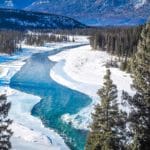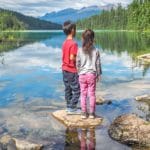Dear reader: This article contains links to products and services that I may be compensated for, at no extra cost to you.
Jasper National Park is a world-class hiking destination, and a Jasper winter hiking trip will never disappoint.
Below I’m going to introduce my personal favourite winter hiking trails in Jasper National Park. Most of these are easy hikes or walking trails that become slightly more challenging in winter. I’ve even done a few of them with my little ones, who are well under the age of 10. The final two entries are the most difficult ones on the list.
For more ideas besides winter walks in Jasper, you may also want to have a look at my guide to the best things to do in Jasper in winter and visiting Jasper with kids!
Table of Contents
The Best Winter Hikes around Jasper Townsite
The following are my 10 favorite Jasper winter hiking trails close to Jasper town. While they aren’t really in any particular order, I’ve put my extra favorite ones first, and finished off with the ones located south of Jasper townsite on the Icefields Parkway, included two difficult bonus ones at the end.
Maligne Canyon Icewalk
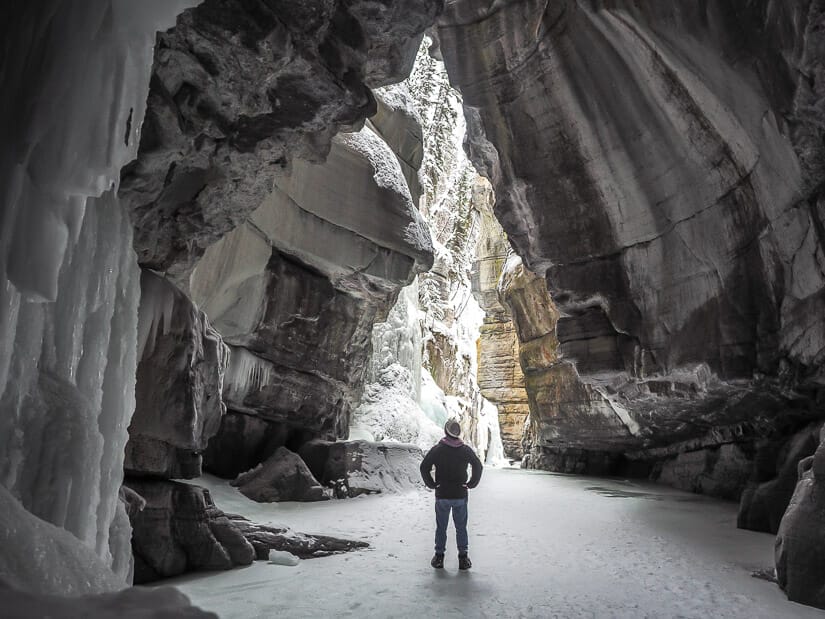
Topping this list is the epic Maligne Canyon Icewalk. For even more information than I’ll provide here, see my article on how to do the Maligne Canyon Icewalk without a guide.
Maligne Canyon is one of Jasper National Park’s most popular attractions. The narrow gorge is carved out by Maligne River, which originates at Maligne Lake, flows into Medicine Lake, then disappears underground before reappearing at Maligne Canyon.
The walking trail through Maligne Canyon is gorgeous throughout the year. The trail includes six bridges across the river and countless views of some of Alberta’s most beautiful waterfalls (and some of the closest waterfalls to Edmonton!)
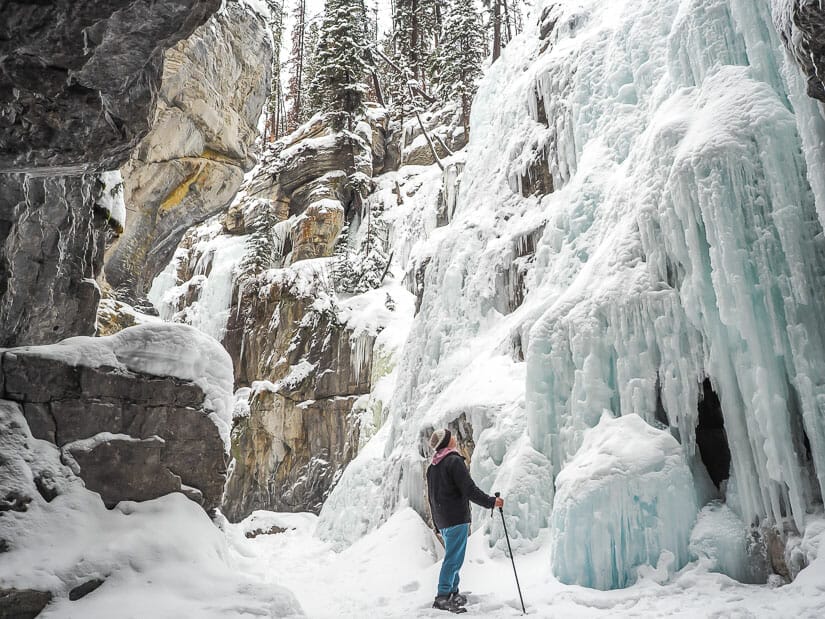
In winter, the gorgeous became a winter wonderland of frozen waterfalls and icicles, making it one of the top things to do in Alberta. The coolest part is that you can descend right onto the frozen river and walk up the canyon. You can even climb into a cave behind one of the waterfalls.
In total, the hike takes 2 to 2.5 hours and ice cleats are essential. The canyon is a 15-minute drive from Jasper townsite on Maligne Lake Road. There’s even an HI hostel right at the canyon.
As you can see from my photos, this winter hike is easy enough to do with kids. It was just difficult enough to push my 5 and 7-year-old to their limit, but they loved it.
Old Fort Point
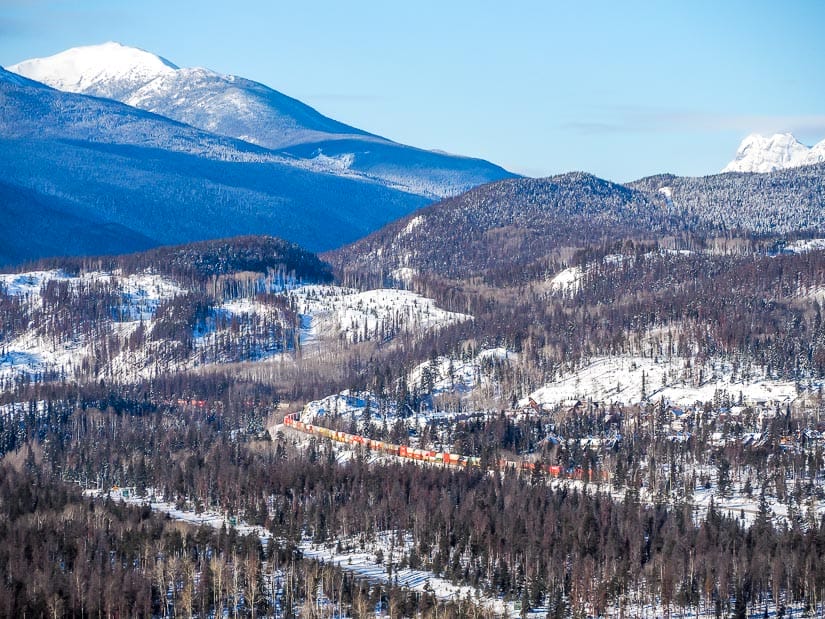
Another of my favourite winter hikes in Jasper is Old Fort Point Trail. The hike takes you to the peak of a 130-meter rocky hill overlooking all of Jasper townsite and the Athabasca River Valley. You can see the full length of trains as they come into and out of town. It’s a truly commanding view for relatively low effort.
The hike starts across the Athabasca River from town; you can walk to the start of it or park in the small lot just after the scenic Old Fort Point bridge. The area around the bridge offers beautiful views of the river and surrounding mountains, including Pyramid Mountain in the distance.
This hike is a loop, or you could just walk to the viewpoint and back for a shorter walk. There’s a pair of the iconic Parks Canada Red Chairs if you go the whole way. The hike’s name refers to an 1811 North West Company cabin in the area. The cabin is no longer there, but it remains a National Historic Site.
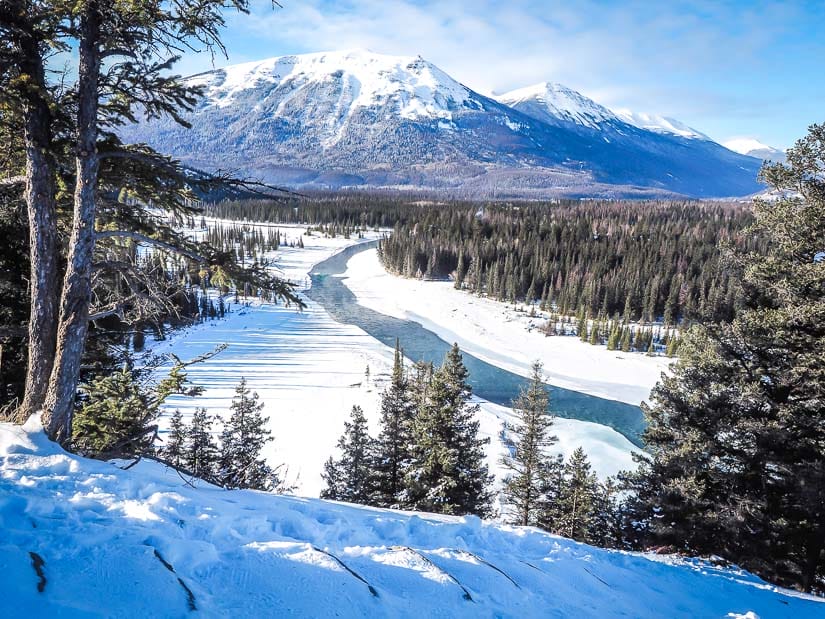
While this hike is normally rated easy and can be done with kids, so long as they can handle some uphill, I would say it’s more of a medium in winter. I don’t think my kids would have made it far. Walking in the snow is more tiring, and some of the steeper uphill sections are a little slippery. Although I didn’t use them, ice cleats and/or a pole would definitely help.
My favorite parts of this hike was that I had it all to myself on a weekday morning (though the -30°C weather might have been a turnoff for some…)
Lake Annette
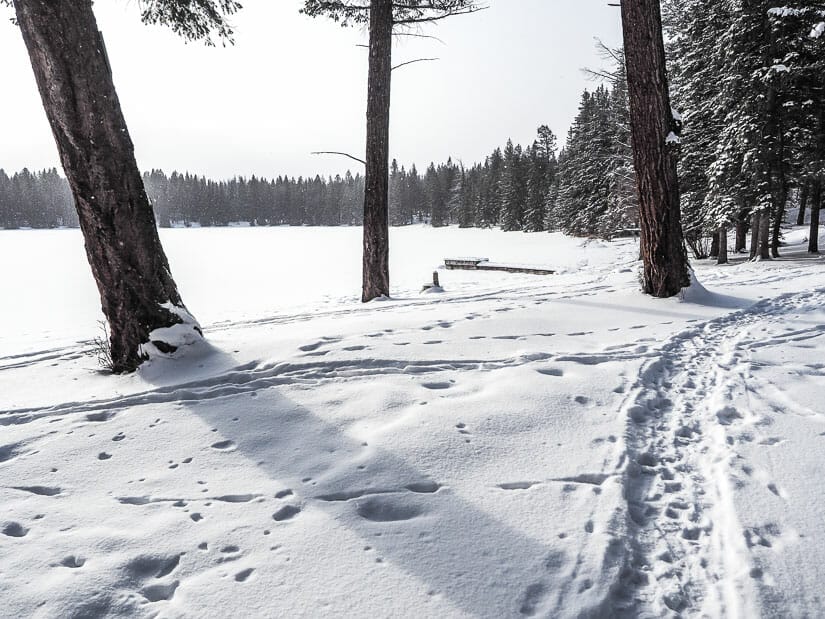
Lake Annette also deserves a high spot on this list. The hike all the way around one of Jasper National Park’s prettiest lakes is a favorite among locals, so the trail worn enough that you won’t be trudging through deep snow. At the same time, it isn’t so popular that you’ll be overwhelmed with crowds like at Maligne Canyon.
Lake Annette, normally known as having one of the few sandy beaches in Jasper, is located just north of the Fairmont Jasper Park Lodge and is accessed via the same road, Old Lodge Road, from which you’ll turn onto Lake Annette Road.
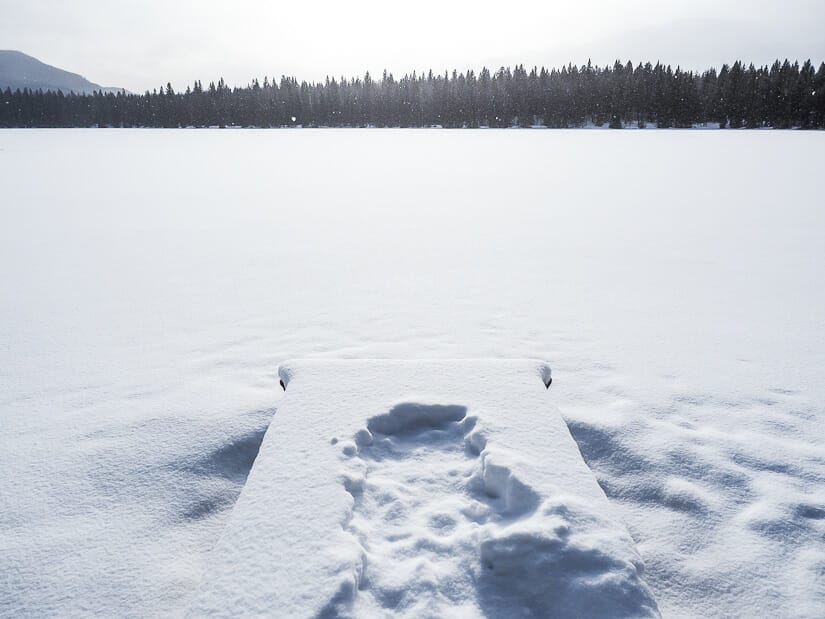
In winter, there are few spots to park for Lake Annette. The first is a small parking lot right beside the lake as you’re driving in. If that’s full, you can just continue to the main parking lot at Lake Annette Beach.
You can budget around an hour to do a full loop of the lake. Depending on conditions and how fresh the snow is, snowshoes or ice cleats can come in handy.
Beauvert Lake
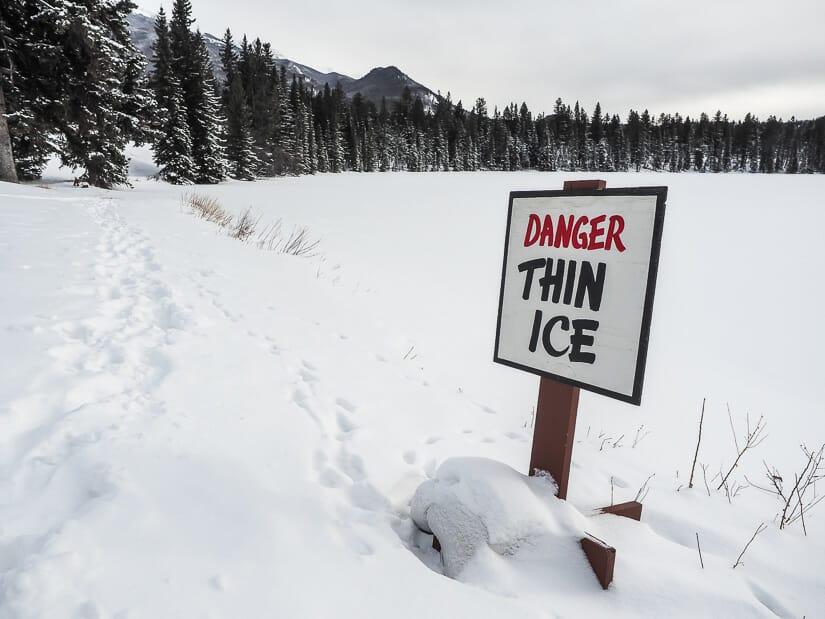
Beauvert Lake (Lac Beauvert) is just south of Lake Annette. Jasper’s most famous hotel, Fairmont Jasper Park Lodge, sits right on its shore. Like Lake Annette, there is a walking trail all the way around the lake. Between the two, I would personally choose Lake Annette, but Beauvert Lake is also worth considering.
Fewer people walk all the way around Beauvert Lake in winter, so the trail may be less worn in winter. If there’s fresh snow, the trail may not be so easy to find in parts. You can access the trail by parking at Jasper Park Lodge and going through The Great Hall and Emerald Lounge.
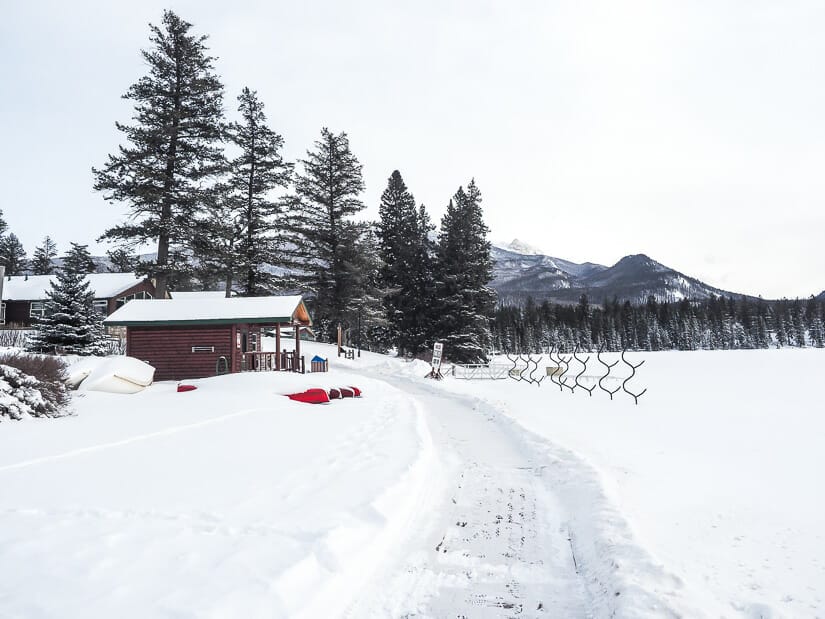
A tempting option here is to just do a part of the lakeside trail, not a full loop, and retire to the Emerald Lounge for a fancy cocktail, like their amazing Maple Old Fashioned (this is exactly what I did). The ice skating trail on Mildred Lake, accessed from the same parking lot, is also free and open to the public.
Another option for this hike is to park at Old Fort Point and walk north on Old Fort Point Road (closed to traffic in winter) to access the south side of the lake and access the round-lake trail. This would be a better (but longer) option if you want to avoid people and the need to park at Jasper Park Lodge, which can get very busy at times.
Pyramid Island
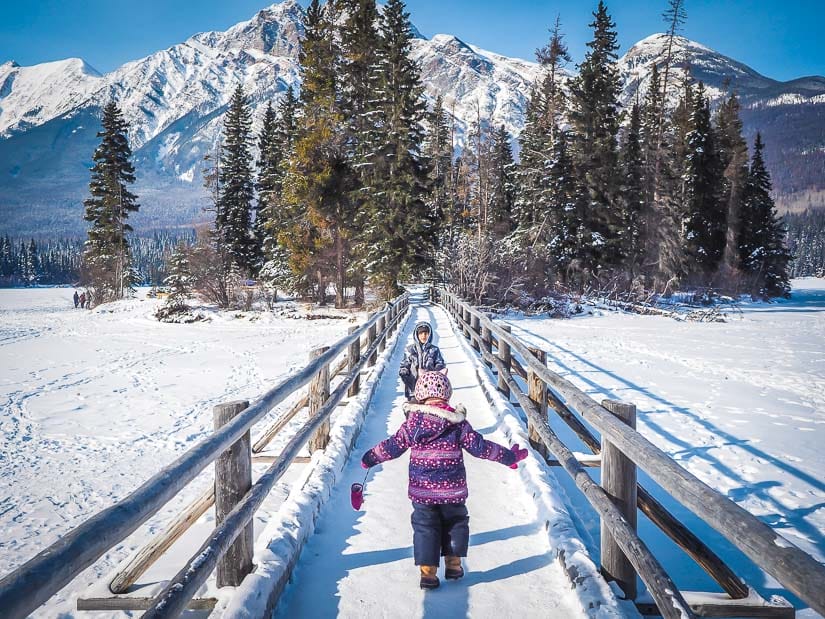
No matter the season, Pyramid Island on Pyramid Lake is an essential Jasper National Park stop for its unbeatable view of (no surprises on the name here) Pyramid Mountain.
The walking trail across a wooden bridge to Pyramid Island is more of a quick stroll than a hike; the total walking distance including a full loop of the island is 0.6 km. But in winter, you walk right on the lake, too, and further explore the area. A historic picnic shelter on the island dates to 1933 and is a federally recognized heritage building.
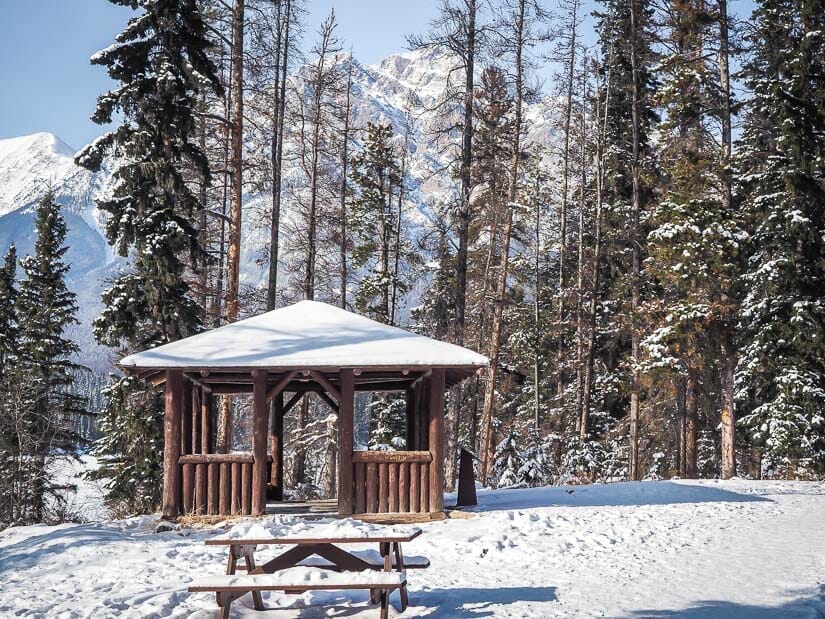
The bonus of doing this lovely winter walk in Jasper is that you can stop at the free Pyramid Lake skating rink maintained by Pyramid Lake Resort. The backdrop to the skating rink is nothing short of epic.
If you’re looking for a longer winter hike in the area Pyramid Lake Loop and Pyramid Lake Overlook are two options that start from the same parking lot at Pyramid Island.
Jasper Discovery Trail
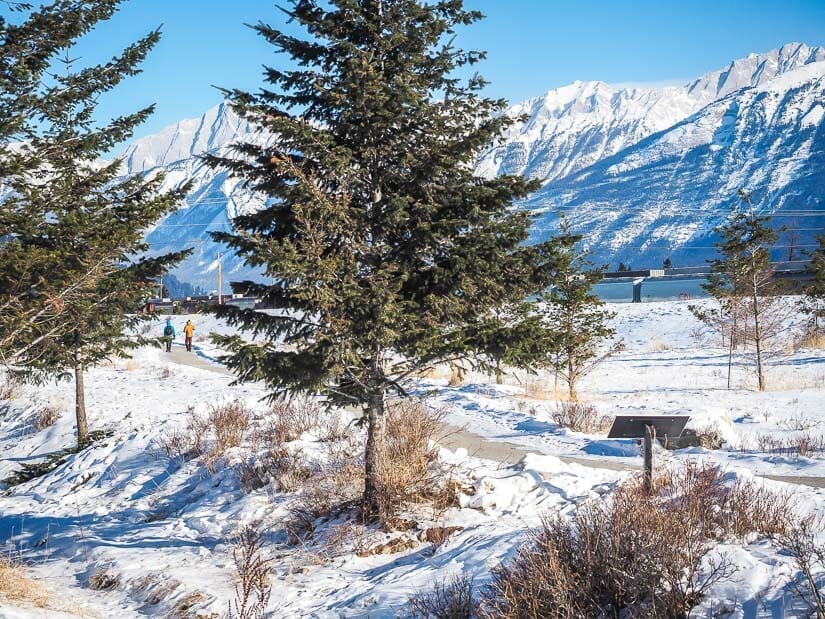
Right in Jasper townsite, Jasper Discovery Trail is a huge loop around the entire town. Although AllTrails lists this is an 8.5 km walk, of course you can just do smaller sections of it at a time.
At the front side of town, the trail follows the main road of town (Connaught Drive). Don’t write this section off, though. It includes the chance to see locomotives up close at the Jasper Train Station, the Haida-made Two Brothers Totem Pole, and more.
At the back side of town, the trail is more natural as is climbs gently up into the woods. There’s also the possibility to connect onto numerous other trails leading to Patricia Lake, Pyramid Lake, and several other small lakes behind town.
Jasper House National Historic Site
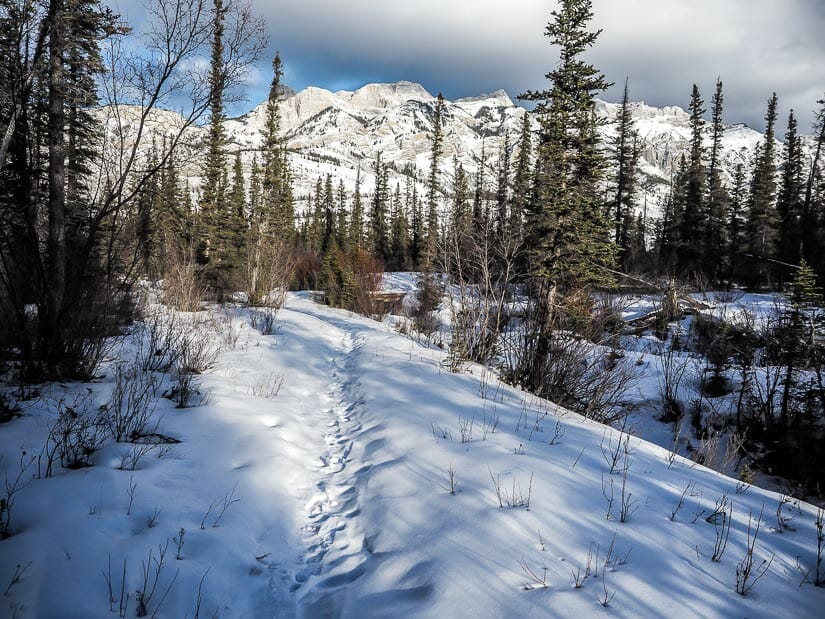
Jumping now to the eastern section of Jasper National Park, Jasper House National Historic Site is a super short and easy walk that makes for a quick stop when driving in on the Yellowhead highway from Edmonton (if you’re from there, also see my guide to the best winter hikes and other activities in Edmonton!)
Jasper House was once a stopping point for fur traders who crossed the Athabasca and Yellowhead passes. There’s nothing left to see of the original house, but there’s an elevated platform overlooking the river and some informational panels.
This winter walk is only 0.8 km return, but it’s a place to stop, stretch the legs, and appreciate some mountain views as you’re driving into Jasper. We prefer it to the road stop at Jasper Lake (technically just a wide stretch of the Athabasca River) a few minutes after it, where everyone else always seems to stop.
Winter Hikes on the Icefields Parkway
The following hikes are located on the Icefields Parkway (Highway 93), which ventures south from Jasper townsite, eventually leading into Banff National Park, the most famous and visited of Alberta’s five national parks (and Canada’s 38 national parks!)
It’s important to note that winter tires are essential on this highway. Heavy snow can also sometimes cause road closures, and the weather can vary dramatically, sometimes dropping by as much as 20 degrees as you travel south.
Valley of the Five Lakes
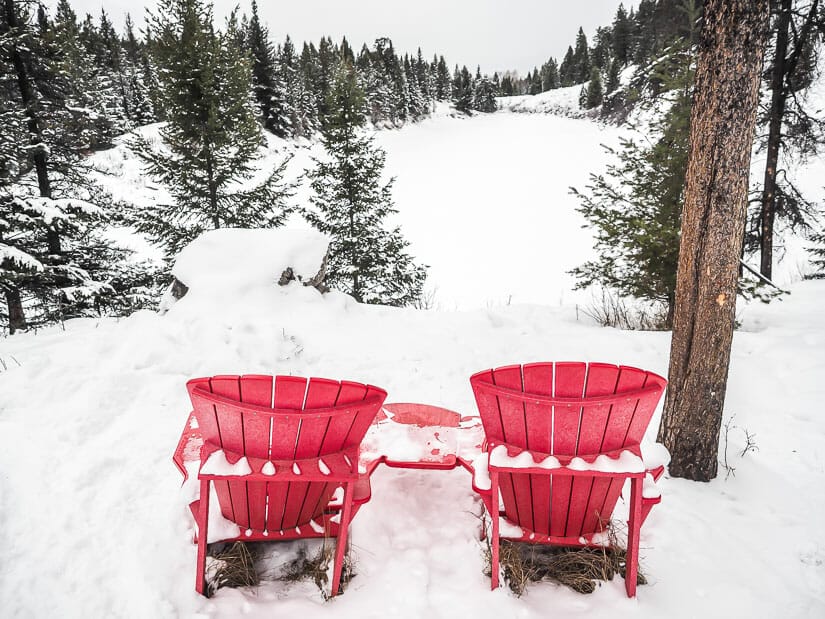
Heading south of Jasper townsite on the Icefields Parkway toward Banff National Park, it only takes a few minutes to reach one of the best Jasper winter hikes: Valley of the Five Lakes.
This is another hike that is considered easy in summer, making it one of the most kid-friendly (but slightly longer) hikes in Jasper. However, in winter a little more effort it required and there are a few slippery ascents/descents, so I’d put this into medium territory.
The trail begins at a large parking lot and leads to a valley containing, you guessed it, five lakes. While there is a longer option to circumnavigate all five lakes, most people follow the main trail which leads between lakes 1 and 2, turns right and follows the shores of lakes 2, 3, and 4, then turns back between lakes 4 and 5.
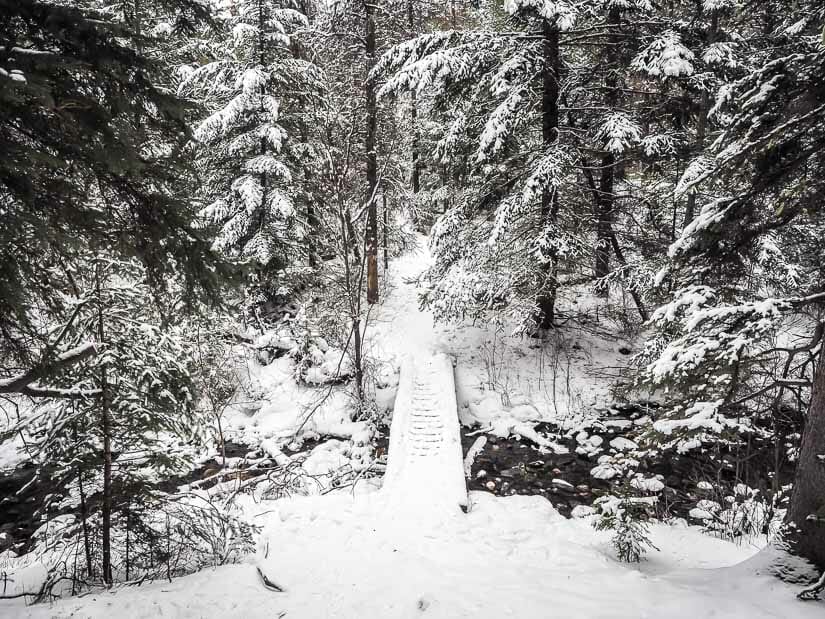
The classic viewpoint of the lakes is from the pair of Parks Canada Red Chairs at the south end of Third Lake. While hiking this trail isn’t as stunning as in summer, when the lakes’ vibrant turquoise colours really make it, it’s a pleasant walk nonetheless, and devoid of the crowds typical in summer.
On my own, I finished this winter hike in 1.5 hours. Ice cleats are not necessary, but I did find my pole helpful for a couple slippery spots.
Athabasca Falls
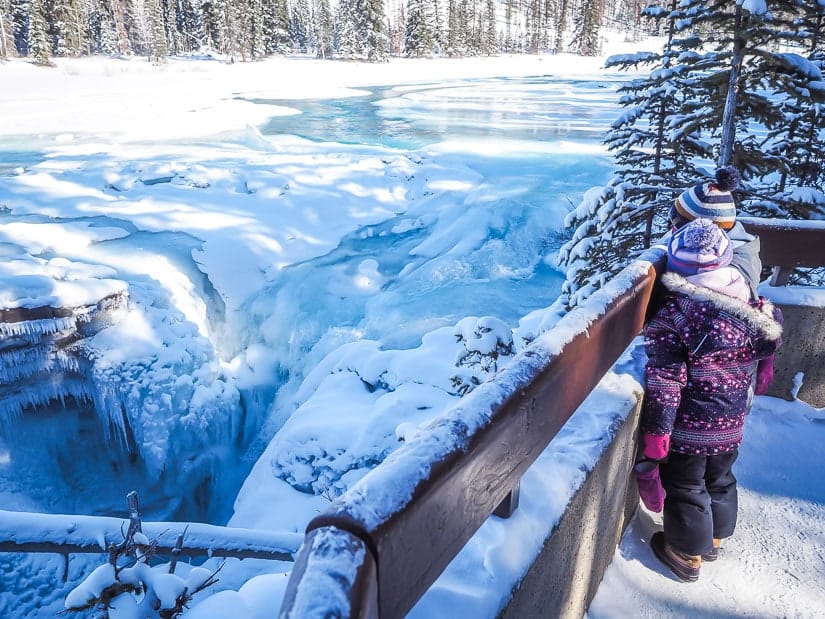
Athabasca Falls is (along with the next entry) the most famous waterfall in Jasper National Park, and the two can easily be visited in a few hours from town, as they are both along the Icefields Parkway.
In winter, Athabasca Falls becomes a frozen spectacle. The very short trail from the parking lot to the various viewing points on either side of the river is hardly a hike but a quick and very scenic stroll. According to AllTrails, if you walk to every possible vantage point and back, that will come to 1 km.
If you’re visiting with kids, this is an especially fun spot, with so many different platforms to explore and look down from.
Upper and Lower Sunwapta Falls
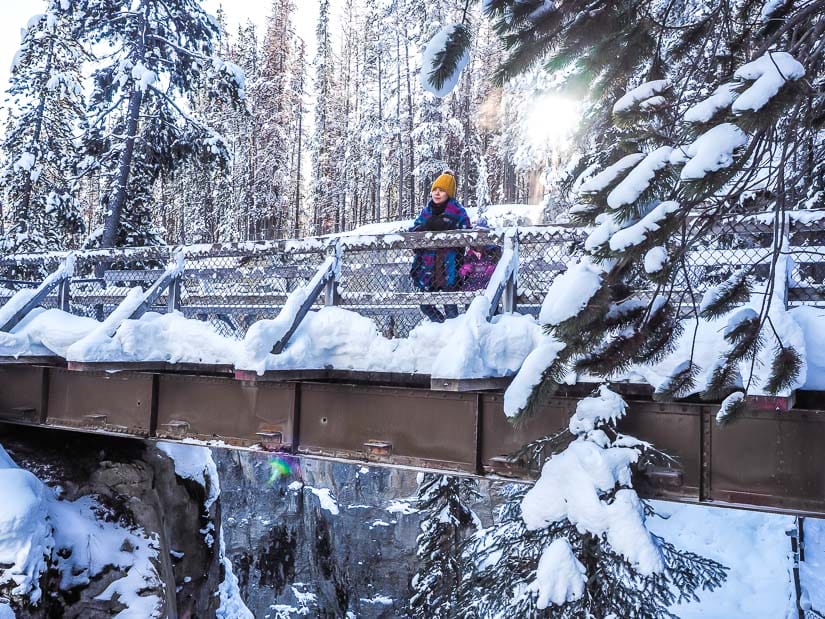
Further upstream on the Sunwapta River, a tributary of the Athabasca, is an equally beautiful water. Like Athabasca Falls, it is a very short walk (only about 100 meters) from the parking lot to the various viewing platforms and a bridge over the river.
Sunwapta stands out here though as it has an actual hiking trail, which leads to the Lower Sunwapta Falls. The hike starts out with some great views looking back at Upper Falls, then leads through the forest downstream to the Lower Falls.
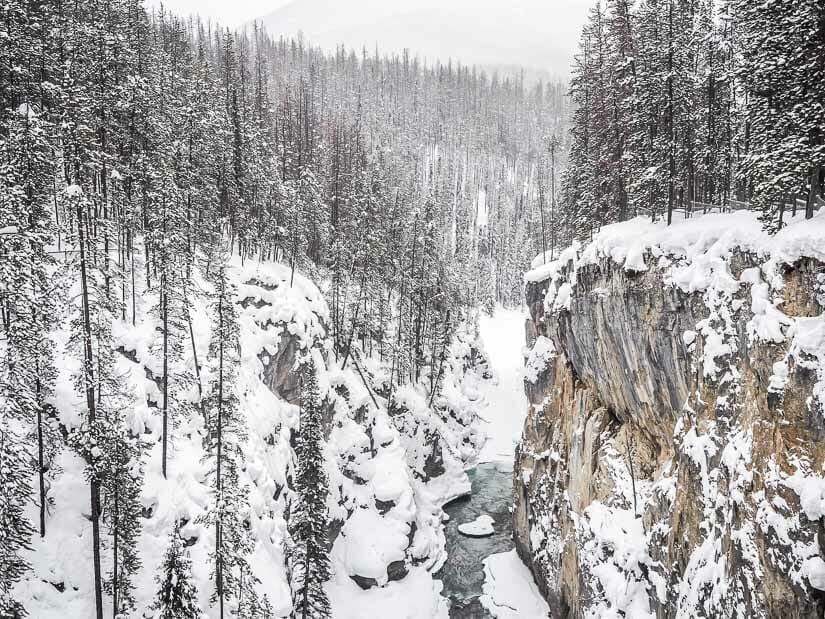
The Lower Falls aren’t as spectacular as the Upper Falls, but still worth the walk. Note that if there is fresh snow like when I visited, the trail may be a little harder to find. Download a GPS hiking map (for example from AllTrails) before you go, as there is zero Internet signal there.
You can budget about an hour return to Lower Falls (3 km).
Toe of the Athabasca Glacier
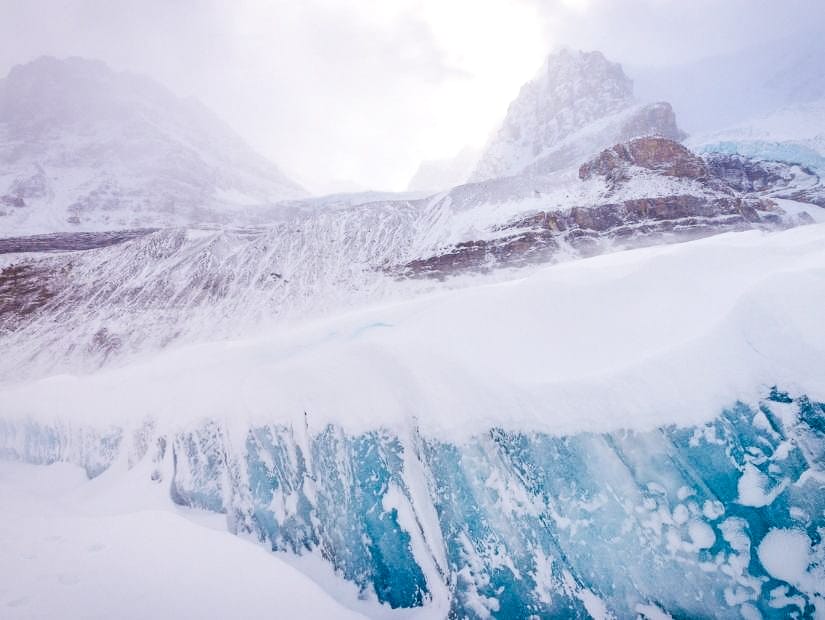
Athabasca Glacier is the most visited glacier in North America, mainly due to its ease of access right on the Icefields Parkway. It is a part of the enormous Columbia Icefield and one of the most popular attractions in Jasper Nationa Park, located just before the highway reaches Banff National Park.
Most visitors come to Athabasca Glacier, when tours are offered by the Columbia Icefield Glacier Adventure, housed in the building across the highway. These can also included a visit to the Columbia Icefield Skywalk up the highway.
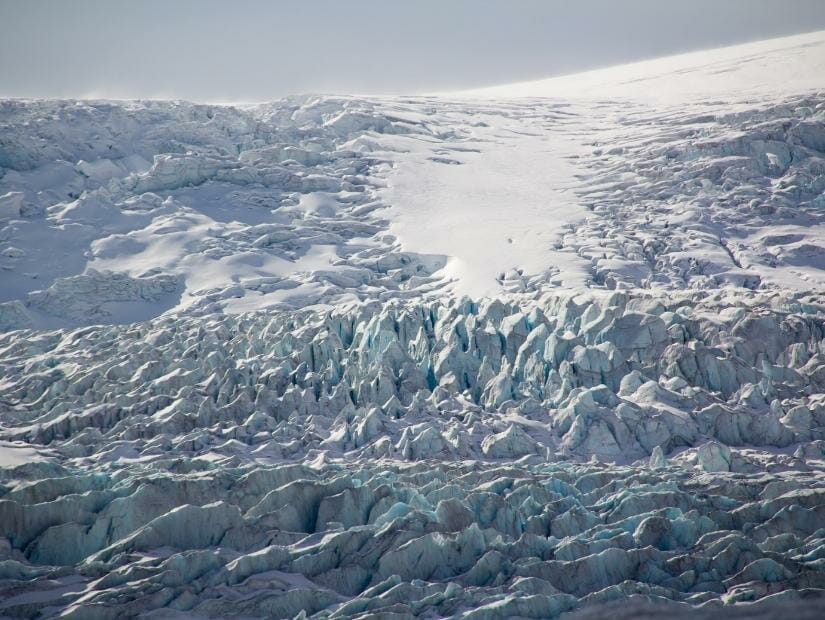
In winter, far fewer people visit the glacier, and the road leading from the highway to Sunwapta Lake at the toe of the glacier is closed. You can still park just off the highway and hike in, though. Therefore, you need to add about 2 km each way (and about an hour) to the hiking trail guide for this one in winter.
Conditions can really vary at the glacier in winter. It can get extremely cold and windy there (keep in mind it already has winter-like conditions in summer!) Walking on the glacier itself should also be avoided because deep cracks and crevices can become invisible when covered in snow in winter. Usually, you can’t make it all the way to the glacier in winter, but you’ll enjoy good views of it as you approach.
Because of the difficulty to reach it in winter and frequent cold/windy weather, I count this one as a tougher hike.
Wilcox Pass
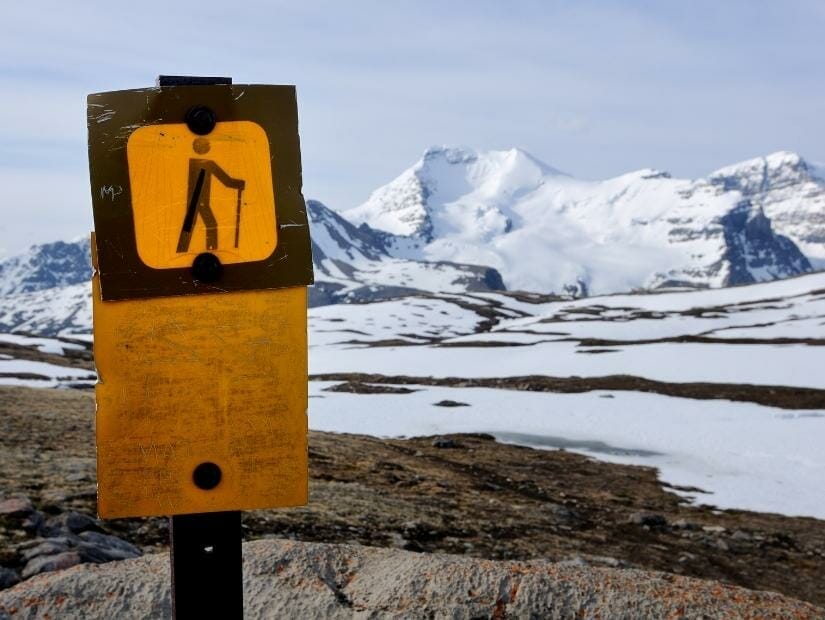
While I haven’t personally done it, Parks Canada lists Wilcox Viewpoint as a difficult Jasper winter hiking option. The trailhead is right on the Icefields Parkway just past Athabasca Glacier.
According to reviewers, snowshoes are a must, especially when there’s fresh snow on the ground. A GPS map downloaded onto your phone is also essential, because the trail can often be obscured by snow. Also heads up that this hike goes into potential avalanche area.
But your reward for doing this winter hike? Epic mountain scenery throughout, and views of three massive glaciers, including the famous Athabasca Glacier itself. There are also two Parks Canada Red Chairs at the viewpoint.
Well, that brings us to the end of this Jasper winter hiking guide. I hope you’ve found some worthwhile winter hiking ideas. Enjoy!

